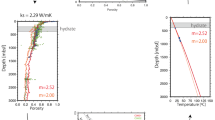Abstract
The article presents the results of a study on the microstructure of fast sea ice in Amur Bay for 2013–2018 based on hydrological observations and magnetic resonance imaging (MRI), as well as the results of calculating the effective and total porosity and permeability of ice cores and their relationship. The profiles and average values of ice permeability and Rayleigh number are calculated from temperature and salinity measurements taking into account the total and effective porosity of the cores. These are compared with the results of a study of the same characteristics for ice in polar regions. The values of the permeability threshold and critical Rayleigh number for the ice of Amur Bay are discussed. MRI images of cores with different permeability characteristics and Rayleigh numbers are presented.



Similar content being viewed by others
REFERENCES
V. V. Bogorodskii and V. P. Gavrilo, “Ice,” in Physical Properties. Modern Methods of Glaciology (Gidrometeoizdat, Leningrad, 1980), pp. 352–375.
A. Yu. Lazaryuk, V. B. Lobanov, and V. I. Ponomaryov, “Evolution of thermohaline structure of waters of the Amur Bay in cold season,” Vest. Dal’nevost. Otdel. Ross. Akad. Nauk No. 6, 59—70 (2013).
N. A. Mel’nichenko, A. V. Tyveev, A. Yu. Lazaryuk, et al., “Vertical distribution of brine and volume structure of thin annual ice in Amursky Bay based on the methods of nuclear magnetic resonance and magnetic resonance imaging,” Oceanology 59, 777—786 (2019).
Yu. Nazintsev and V. V. Panov, Phase Composition and Thermophysical Characteristics of Sea Ice (Gidrometeoizdat, St. Petersburg, 2000).
J. Büttner, PhD Thesis (Geophys. Univ., Bergen, 2011).
G. Carnat, T. Papakyriakou, N. X. Geilfus, et al., “Investigation on physical and textural properties of Arctic first-year sea ice in Amundsen Gulf, Canada, November 2007–June 2008 (IPY-CFL system study),” J. Glaciol. 59, 819–837 (2013).
G. F. N. Cox and W. F. Weeks, “Equations for determining the gas and brine volumes in sea-ice samples,” J. Glaciol. 29, 306–316 (1983).
O. Crabeck, R. Galley, B. Delille, et al., “Imaging air volume fraction in sea ice using non-destructive X-ray tomography,” The Cryosphere 10, 1125–1145 (2016).
J. Freitag, “The hydraulic properties of Arctic sea ice-implication for the small-scale particle transport,” Ber. Zur Polarforsch. 325 (1999);
PhD Thesis (Univ. Bremen, 1999).
R. J. Galley, B. G. T. Else, N.-X. Geilfus, et al., “Imaged brine inclusions in young sea ice – Shape, distribution and formation timing,” Cold Reg. Sci. Technol. 111, 39–48 (2015).
K. M. Golden, S. F. Ackley, and V. I. Lytle, “Percolation phase transition in sea ice,” Science 282, 2238–2241 (1998).
K. M. Golden, H. Eicken, A. L. Heaton, et al., “Thermal evolution of permeability and microstructure in sea ice,” Geophys. Res. Lett. 34, L6501 (2007).
D. Notz and M. G. Worster, “Desalination processes of sea ice revisited,” J. Geophys. Res.: Oceans 114, C05006 (2009).
C. Petrich and H. Eicken, “Growth, Structure and Properties of Sea Ice,” in Sea Ice (Willey-Blackwell, Oxford, 2010), pp. 23–77.
C. Petrich, P. J. Langhorne, and Z. F. Sun, “Modelling the interrelationships between permeability, effective porosity and total porosity in sea ice,” Cold Reg. Sci. Technol. 44, 131–144 (2006).
F. Scott and D. L. Feltham, “A model of three-dimensional evolution of Arctic melt ponds on first-year multiyear sea ice,” J. Geophys. Res. 115, C12 (2010).
J. S. Wettlaufer, M. G. Worster, and H. E. Huppert, “The phase evolution of young sea ice,” Geophys. Res. Lett. 24, 1251–1254 (1997).
Funding
The study was carried out within a state assignment (topic no. 121021700346-7 “Investigation of the Main Processes Controlling the State and Variability of Oceanological Characteristics of the Marginal Seas of Asia and Adjacent Regions of the Pacific and Indian Oceans”).
Author information
Authors and Affiliations
Corresponding authors
Ethics declarations
The authors declare that they have no conflicts of interest.
Rights and permissions
About this article
Cite this article
Melnichenko, N.A., Tyuveev, A.V., Lazaryuk, A.Y. et al. Relationship between Permeability, Porosity, and Microstructure of Sea Ice in Amur Bay Based on In-Situ Measurements and Magnetic Resonance Tomography. Oceanology 62, 464–470 (2022). https://doi.org/10.1134/S0001437022040166
Received:
Revised:
Accepted:
Published:
Issue Date:
DOI: https://doi.org/10.1134/S0001437022040166




